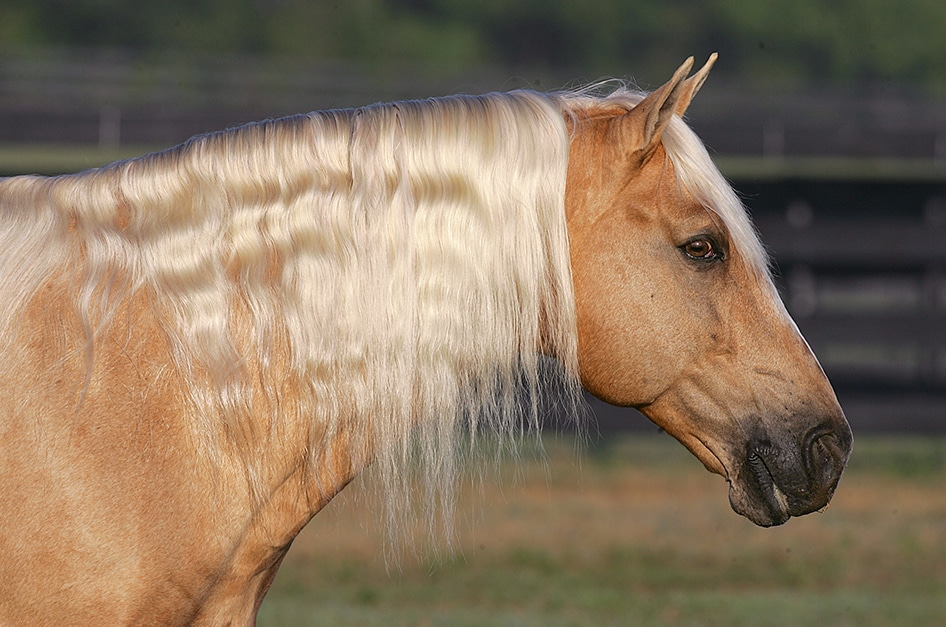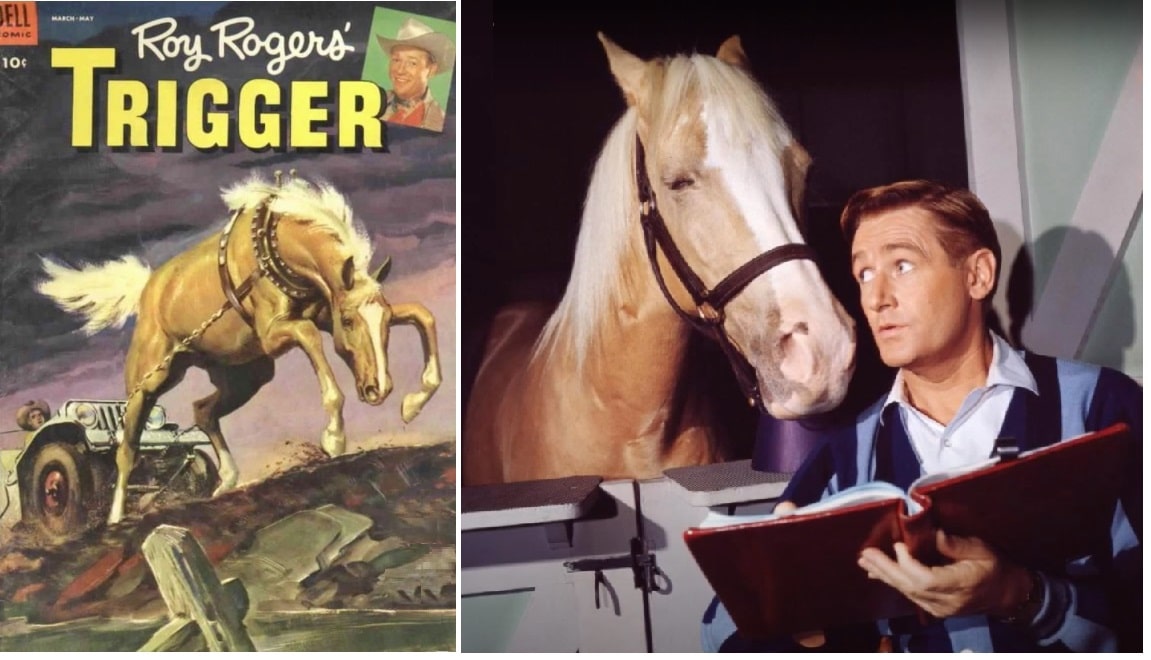Palomino is considered a colour breed – a genetic colour in horses rather than a specific breed of horse. The distinctive palomino colouring consists of a golden coat and white mane and tail. Genetically, this colour is created by a single allele of a ”cream” dilution gene and a “red” or chestnut base coat. It’s not rare but is highly desirable. Because the cream dilution gene is heterozygous, the colour does not breed true. That means you can mate two registered Palominos and you may or may not get the signature golden-coloured offspring. A Palomino horse has a 50% chance of passing on his colour to a foal, but if he is mixed with a cremello or Perlino mare there is a 100% chance of having a Palomino.
The flaxen mane of a palomino Tennessee Walking Horse.
Where did Palominos originate?
The origins of the Palomino horse will never be known for certain. Golden horses with ivory manes and tails are believed to have descended from Arab and Barb horses, and are associated with desert climates, but golden coloured horses also appear in ancient Japanese and Chinese art and Far East tapestries predate all Arabian sources.
The characteristically golden coloured horse with the tail and mane of an ivory hue has been mentioned in the legends of several different desert countries and stories of golden horses abound in Arabic and Moorish myths and legends. Reports from the Crusaders who fought the desert dwellers mention beautiful gold coloured horses. The desert origin theory suggests that a desert horse evolved a golden sand color as camouflage to protect against predators.
Queen Isabella I of Spain, the monarch who funded Christopher Columbus’s expedition to the New World in 1492, owned one hundred Palominos. Historical documents indicate she sent a stallion and five mares to New Spain during her reign. Those golden horses and others no doubt helped spread the colouring into Texas and eventually other US states. In the Spanish colonies in South America, Mexico being the largest, Palomino horse are still called Isabellas.
What Horse Breeds are Palomino?

The US-based Palomino Horse Breeders Association, formed in 1941, accepts Quarter Horses, Paints, Holsteiners, Pintos, Appaloosas, Thoroughbreds, American Saddle Horses, Arabians and half-Arabs, Morgans, Mountain Pleasure Horses, Morabs, Quarabs, Missouri Fox Trotters and Rocky Mountain Horses registered with their respective US associations as long as they meet the colour and white rules.
Characteristics
As Palominos can be found within many breeds, their conformation varies, but generally they must show refinement of head, bone, and overall structure. Ideally, they should be the colour of a gold coin, varying from light, medium, to dark. The mane and tail should be white, ivory, or silver, with a small percentage of dark or sorrel hair mixed in. Preferred height is 14-17 hands.
Are Palominos good for beginners?
Palominos can be found within many breeds, so the question is difficult to answer as it would depend on the temperament and level of training of the individual horse. Horse riders of all levels, including beginners and those who have minimal amounts of experience, tend to favour Palominos for mounts at riding camp, for trail rides and for lessons.
What are Palomino Horses Used For?
Because of their striking colour, Palominos are popular in parades and at horse exhibitions, as well as rodeos, and for pleasure riding, ranching, jumping, and racing, and in both English and Western shows.
Famous celebrity palominos include Roy Rogers’ Trigger, and more recently, Xena the Warrior Princess’s horse Argo was Palomino.
The famous Mr. Ed from the 1960’s comedy show is perhaps the most famous Palomino horse. This ‘talking horse’ was played by a gelding named Bamboo Harvester. The show was filmed in black & white, so it’s hard to tell, but Mr. Ed had a gorgeous golden coat, white mane and tail.
What are the four Palomino color variations?
The typical Palomino horse colouring is golden cream with a white tail and mane. But there are four variations on the default color; they are pearl, chocolate, golden, and light palomino.
Pearl palomino
Pearl palomino horses have a luxurious sheen on a light cream coat. Pearl palominos have either green or blue eyes. They are found in some Andalusian and Lusitano strains; however, they are rare in all breeds.
Chocolate palomino
Chocolate, like pearl palominos, is a rare color. It’s created by crossing a palomino and a liver chestnut. It meets the genetic classifications of palomino horses in that it has the creme dilution gene and chestnut base.
A chocolate palomino has a coat that looks dark brown with a white mane and tail. They often have small amounts of black or brown hair in their manes or tails. The color pattern is of a chocolate palomino is beautiful.
Golden palomino
Golden palominos are the color pattern most of us envision when palomino horses are mentioned. Their coats are the color of gold coins, and their manes and tails are white.
Sandy or light palomino
A light palomino horse has a light sandy colored coat with a white mane and tail. They look similar to a cremello, without the pink skin. A cremello has pink skin, and a light Palomino has brown skin. A cremello has two creme dilution genes compared to one in a palomino.
Palomino horses colour can change during the year, especially in cold climates depending on the environment, the season and their diet. Hay and grass diets versus grain that is higher in protein can lighten or darken coat colour and even affect dappling. Palominos can also undergo dramatic color changes as the seasons change and their winter and summer coats can appear uniquely different.
For more information, visit:
Palomino Horse Breeders Association
Palomino Horse Association




